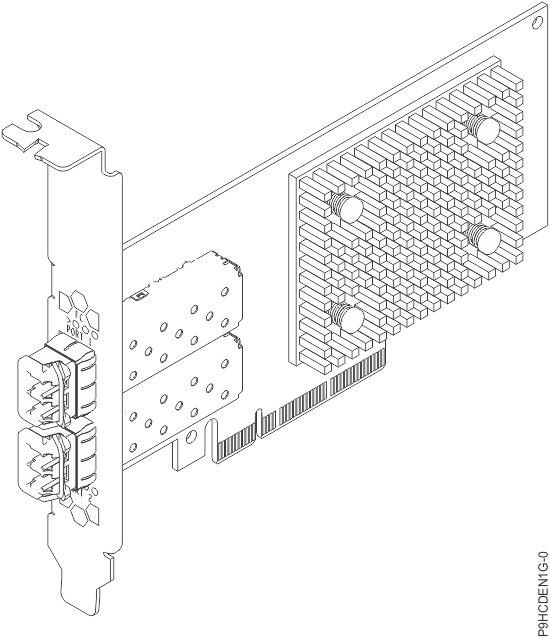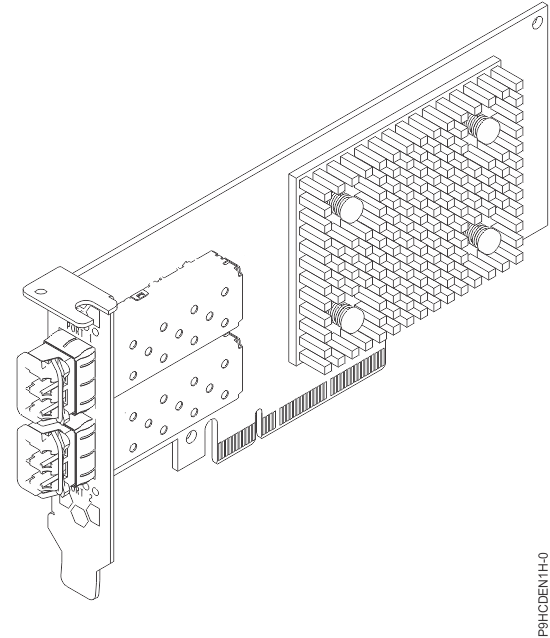PCIe3 x8 2-port Fibre Channel Adapter (16 Gb/s); (FC EN1G and EN1H; CCIN 579B)
Learn about the specifications and operating system requirements for the feature code (FC) EN1G and EN1H adapters.
Overview
The FC EN1G and EN1H are electronically identical. FC EN1G is a full-height adapter and FC EN1H is a low-profile adapter.
The PCIe3 x8 dual-port Fibre Channel (16 Gb/s) adapter is a PCI Express (PCIe) generation 3 (Gen3) x8 adapter. This PCIe adapter is based on the Marvell QLE2692 PCIe host bus adapter 15.2 cm x 7 cm (6.6 inches x 2.7 inches). The adapter provides two ports of 16 Gb Fibre Channel capability by using SR optics. Each port can provide up to 16 Gb fibre channel functions simultaneously. Each port provides single initiator capability over a fiber optic link or with N_Port ID Virtualization (NPIV) it provides multiple initiator capabilities. The ports are small form-factor pluggable (SFP+) and include an optical SR transceiver. The ports have LC-type connectors and use shortwave laser optics. The adapter operates at link speeds of 4, 8, and 16 Gbps and it automatically negotiates to the highest speed possible. The adapter can be started on IBM Power Systems with FCode.


Specifications
- Item
- Description
- Adapter FRU number
- 02CM904
- I/O bus architecture
- PCIe3 x8
- Slot requirement
- For details about slot priorities, maximums, and placement rules, see PCIe adapter placement rules and slot priorities and select the system you are working on.
- Cables
- See Cables for details.
- Voltage
- 3.3 V, 12 V
- Form factor
- Short, low-profile
- Maximum number
- For details about the maximum number of adapters that are supported, see Adapter placement rules and slot priorities and select the system you are working on.
- Attributes provided
- Enhanced diagnostics and manageability
Cables
- OM4: Multimode 50/125 micron fiber, 4700 MHz x km bandwidth
- OM3: Multimode 50/125 micron fiber, 2000 MHz x km bandwidth
- OM2: Multimode 50/125 micron fiber, 500 MHz x km bandwidth
- OM1: Multimode 62.5/125 micron fiber, 200 MHz x km bandwidth
| Header | Cable Type and Distance | |||
|---|---|---|---|---|
| Rate | OM1 | OM2 | OM3 | OM4 |
| 4 Gbps | 0.5 meters to 70 meters (1.64 feet to 229.69 feet) | 0.5 meters to 150 meters (1.64 feet to 492.12 feet) | 0.5 meters to 380 meters (1.64 feet to 1246.72 feet) | 0.5 meters to 400 meters (1.64 feet to 1312.34 feet) |
| 8 Gbps | 0.5 meters to 21 meters (1.64 feet to 68.89 feet) | 0.5 meters to 50 meters (1.64 feet to 164.04 feet) | 0.5 meters to 150 meters (1.64 feet to 492.12 feet) | 0.5 meters to 190 meters (1.64 feet to 623.26 feet) |
| 16 Gbps | 0.5 meters to 35 meters (1.64 feet to 114.82 feet) | 0.5 meters to 100 meters (1.64 feet to 328.08 feet) | 0.5 meters to 125 meters (1.64 feet to 410.10 feet) | |
Adapter LED
Green LEDs can be seen through openings in the mounting bracket of the adapter. Table 2 summarizes the LED states for this adapter.
| State | Green LED (16 Gbps) | Green LED (8 Gbps) | Green LED (4 Gbps) |
|---|---|---|---|
| Power Off | Off | Off | Off |
| Power On (Before Firmware Initialization) | On | On | On |
| Power On (After Firmware Initialization) | Flash | Flash | Flash |
| Firmware Fault | Flash in sequence | Flash in sequence | Flash in sequence |
| 4 Gbps Link Up/ACT | Off | Off | On / Flash |
| 8 Gbps Link Up/ACT | Off | On / Flash | Off |
| 16 Gbps Link Up/ACT | On / Flash | Off | Off |
| Beaconing | Flash | Off | Flash |
Operating system or partition requirements
- The latest version of enabling libraries and utilities can be downloaded from the Fix Central website.
- Power Systems Prerequisites website.
- IBM System Storage Interoperation Center (SSIC) website.
- The latest version of the device driver or IBM® Power® RAID adapter utilities (iprutils) can be downloaded from the IBM Service and Productivity Tools website.
- For information about important notices for Linux on IBM Power Systems, see the Linux® on IBM website.